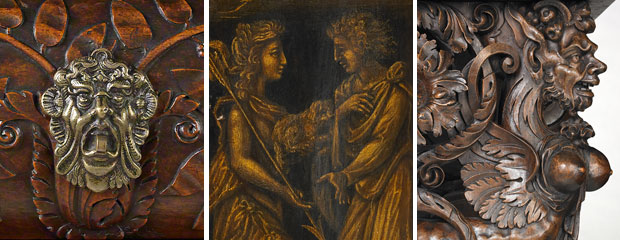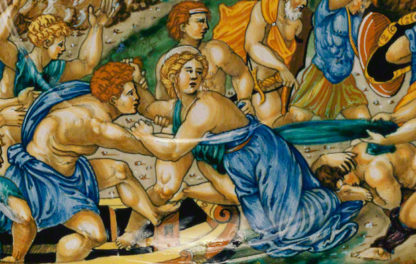Question of the Week is a series inspired by our Masterpiece of the Week tours, offered daily at 4:00 p.m. Featuring an open and upbeat discussion among visitors and gallery teachers, the tours feature a new object and pose a new question each week.

Cabinet by an unknown maker, French 1580 with minor additions from the late 1850s. Carved walnut and oak with painted panels, linen and silk lining. 10 ft. 1 1/8 in. high. Details below: drawer pull, grisaille painting on the right door, and a carved figure
What is fake? What is real? Who decides?
Copies and forgeries of art have been around since, frankly, art. The Romans copied Greek originals. The infamous Han van Meegeren forged the paintings of Johannes Vermeer and Frans Hals.
This elaborately carved French Renaissance-style cabinet was purchased in 1971 by J. Paul Getty against the advice of his curators, who thought it was a fake from the 19th century. The piece was relegated to storage for years.
But knowledge, even in a museum, changes over time. In 2001, one of our curators launched a re-examination. Through close visual analysis, as well as carbon dating and dendrochronology, the cabinet was declared to be—mostly—genuine, dating to 1580. See how conservators, curators, and scientists worked their magic in the video below.
To scholars, knowing an object’s true date is key to understanding it. But what about you? Does knowing that this beautiful cabinet is from 1580—as opposed to 1880—make you look at it differently? If so, why?

And does the museum’s stamp of approval make you appreciate this amazing work more? After all, it’s the same object either way.




I’ve often wondered about this very issue. Even if two works of art are physically the same — an original, say, and an exact copy — they feel profoundly different to me. Is it possible that an object contains within it some of its story, or has a spirit, or has embedded “knowledge” of its own history?
About this cabinet, if the museum displayed it as a 19th-century copy of a Renaissance original, I probably wouldn’t stop to look at it. The fact that I know it’s a Renaissance object makes me actually take the time to stop, look, and appreciate. Maybe that’s the real difference between real, fake, and replica — it’s the observer that’s different, not the object.
It kind of blows my mind that the amazing quality of this cabinet couldn’t stand on its own. Even if it was from the 19th century, so what?! It’s beautiful, and the carving and imagery is so masterfully done and spectacular that you’d think curators would value it for this alone.
It makes me think of how impressionable humans are – that the opinion of a few curators/experts would be accepted without thinking. Although Getty seemed to know something of value was here…but then it ended up in storage. Makes me think of the way much modern art is valued. If an expert tells us it is “important,” voila, it is! (and the $$ value goes up too!)
Hello Susan and Christiana,
You’ve made interesting points. You’ve both hit the ‘rose tack’ on the head here. The intersection between the object and viewer is what brings the museum to life. We really need to be active participants. Expertise and knowledge change over time. It’s important to think and ‘look’ for ourselves.
I think it’s just as beautiful as it was if it was a forgery. However, the fact that it’s older than we thought- and the thought that J. Paul Getty put his faith in it in spite of opposition- makes it an even more interesting part of history. Lucky Cabinet!
Hi Crystal,
Yes, it is truly a marvelous piece of furniture. I often refer to it as a display cabinet that is ‘displaying’ itself. Discovery in field of the history of art is an on-going process. In 2001, curators in France organized a small exhibition on the work of renowned 16th-C cabinetmaker Hugues Sambin, which prompted a Getty curator to launch a thorough reexamination of the Museum’s cabinet. Thanks to that curator’s open-mindedness, ostensibly against the general consensus, we are able to appreciate this piece’s complex history today.
Christiana’s reaction raises an interesting point about attraction versus suggestion. Isn’t it better to give your attention to things that attract you, that catch your eye as you walk through the door? You can choose to read the identification – or not. The words “Renaissance” and “copy” shouldn’t affect your enjoyment of a piece.
Hi Valerie,
The fact that everyone responds differently to works of art makes going to museums a fun and open-ended experience. Some people are struck by the formal or aesthetic qualities of an object, while others are more intrigued by its history. For the latter, a museum can function as a time machine that offers a great escape into a different era and culture. Museums are great for both.
Hi,
I just think it’s an incredible story and what is more important is that it is not in storage anymore and its beauty is there for all to see. I really do think it is subjective, a case of we always believe what the experts say, without question. I tend to agree with Christiana, if it was displayed as a replica, I probably wouldn’t stop and look!
Regards
Mike
As an art historian, the authenticity does matter to me. As in, is this actually Renaissance-era decoration or is it a later conception of what Renaissance decoration should be? To me it’s interesting how the piece seems to fuse medieval and classical decorative elements. Which gives flavor and context to the period: it’s a moment in time in which both the medieval past and the classical past are equally influencing personal taste.
If it’s an original piece, it can say a lot about the artist and the person who commissioned the work. If it’s a copy, it might say more about how 19th century patrons/artists viewed the Renaissance because we can’t be use that it’s an accurate copy of an original piece or a combination of multiple elements. Also all the hand carving has meaning in an era of increasing factory production; it’s proof of the wealth of the commissioner that they can hire skilled labor to carve it as a unique object just for them.
I guess it depends on what the museum wants the lay public to get out of the display of objects. If the purpose is to educate people about the history and development of art, it’s essential to correctly label where the object stands in the timeline of artistic development. If it is just a beautiful object, and that’s all people are going to get out of it, it doesn’t much matter.
There is a large gap between enjoyment and understanding of an object. Yes, I think it’s an amazingly beautiful object. But because it is a historical object, it has a history. It had a use for which it was commissioned. Also why do we find it beautiful? What does the aesthetic value we place on an object mean? Is an Indian temple just as beautiful? Or Chinese calligraphy? Or is it beautiful because we have been surrounded by similar decorative motifs all of our lives? See: Beaux arts buildings in NYC which use the same kinds of Classical motifs in their decoration.
The whole debate on the hierarchy of what is worthy is something that we often discussed in my undergrad courses. Those of us who are trained as art historians can sometimes be snobs about the quality of an object depending on whether or not we believe it to be authentic as well as a good example of its particular genre or the oeuvre of the artist. Depending on the time period of object/artworks, we’re still coming from an 18th century viewpoint on what is good and worthy. I do agree that it’s important to properly label objects so that the public can be educated, but it’s just as important for the casual visitor to be able to walk around the galleries and enjoy the works because they find them beautiful. Remember that J. Paul Getty originally did not have educational labels or any sort of gallery interpretation when the original museum opened in the 1950’s. He wanted the visitors to experience and interpret the artworks for themselves. The casual visitor doesn’t care what some New York or London scholar/critic has to say. Yes, we’ve put a lot of effort into our educations and research, but at the end of the day if someone likes a painting or a cabinet, despite it’s being a copy, that visitor got something out of the experience.
… and in fact, there is quite a lot of skill and talent that goes into copying something of this caliber. The one who copies such a piece must be highly skilled in their own right and therefore must be appreciated just for that.
The difference between observing an authentic and a fake is the means used to produce them. If it’s a 15th century object it was definitely made by hand and the artist took a lot of pains to achieve the marvellous finish that the cabinet has. On the other hand, if it is a later production, probably made after the industrial revolution, the artist may not have done everything by his own hands. The use of machines in making the artwork is what reduces its value. Any art object is not as valuable if it was made by machine. At least that is what I think. I will value a handmade paper more that a machine made one.
Precisely, The time period in which an object is made is completely relevant due to the required or lack of ingenuity and talent to achieve the work.
Anjali (wonderful name by the way) has distinguished the quality of the art as to whether it is handmade or machine made. For me that is also the difference in the level of care and love that was instilled in the piece during it’s creation. I like to wonder what the creator was thinking about as he/she carved a particular element. And what the inspiration was for that particular element. A machine has no love to give or thought of inspiration.
This entire discussion hits on a very important point. I’ve heard people say that questioning an expert’s opinion is quite arrogant. However, let us just look at the relatively short period that this gorgeous work of architecture and craftsmanship has spent in this one museum. Note how many different experts have given so many different mistaken opinions during this short time period.
This tells me that regardless of your level of education and knowledge if your instinct is telling you that something isn’t right you should give yourself some credit. Listen to that inner voice which is inspiring further investigation.
A great parallel to this story is that of Salvator Mundi by Leonardo Da Vinci. After centuries of being in the collections of kings, the painting was deemed a fake by many art experts. Along its strange path back to the top of the art world it was sold as a fake in 1958 for only 45 pounds. Think about that. 45 pounds. Any of us mere mortals could have bought it, held it and hung it in our own modest home just because several people who thought themselves experts clearly didn’t know what they were talking about. But in 2017 after much research the painting sells again being heralded by the experts of the art world as being the real deal. It sells for a small sum of $450,000,000.00.
This is why we as observers in this world need to ask questions that challenge the “leading experts”.
This is also why I shop flea markets and thrift stores.